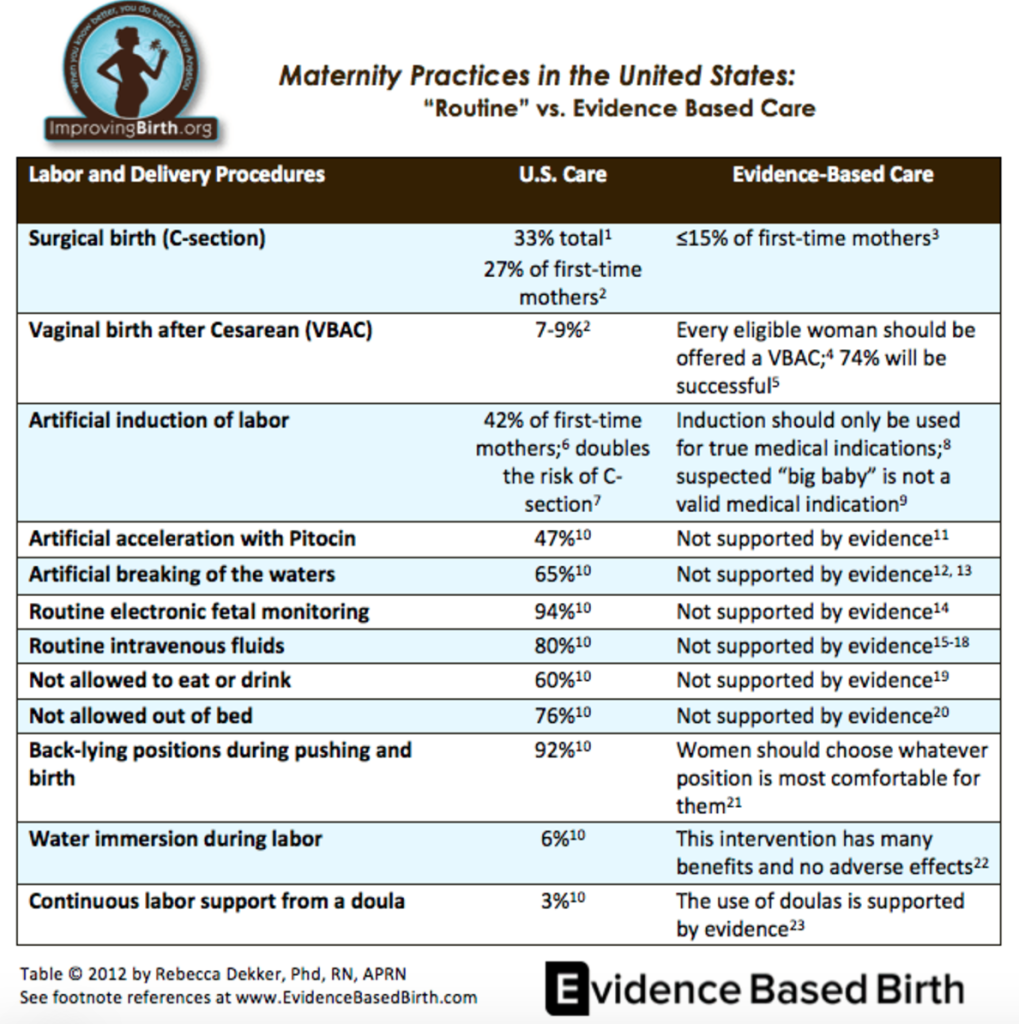Why evidence based maternity and birth care are important
Simply put, evidenced-based maternity care and birth are policies and procedures based on proven scientific evidence from medical research and peer-reviewed journals. It is the practice of effective care with the least amount of harm. Unfortunately in many parts of the world, standard hospital care is not practiced in this way. In fact, many hospital procedures go in direct contrast to recent medical evidence, and increase the risks for healthy mothers and babies.
Standard care in hospitals can be intervention-intensive. IVs, continuous electronic fetal monitoring, epidurals, restricting food and drink, restricting movement, and having mothers push in the supine position all increase stress to the mother and baby, disrupt the natural flow of hormones, and may lead to complications.
There are a few reasons for this dichotomy between research and practice

Tradition
Many birth practices in America, were put in place in the 1950s and 60s, using research based on the past rather than looking forward. Although more information and education is now available, it is a challenge to turn research into practice. Traditional methods are simply easier to continue.
Profit
It benefits hospitals financially to use interventions like induction, pitocin, epidurals, c-sections, and lengthened recovery stays.

Liability
OB/Gyns can be nervous about being sued, and for good reason. They are the second highest sued doctors after neurosurgeons. If worry creeps in to a doctor’s mind about the “traditional potential dangers” of labor (say, if water has been broken for a while, baby’s heart rate is decelerating, labor has stalled at a certain point, or the pushing phase is getting long), he can choose to order a c-section. If he is potentially sued, he can make the case that he took action by doing all he could, rather than waiting it out. The same can happen with other worries before labor—if a woman measures big, or has some minor concerns, a doctor may order induction to prevent possible negative outcomes and being sued.
Convenience
Unfortunately, these situations happen more commonly than they should. An OB might have a vacation coming up and therefore will push an induction to have the birth before he leaves. He might be at the end of a very long shift and ready to go home, so may order some pitocin to be administered to speed up the labor. It’s a sad reality, but it does occur.
Reliance on Specialists
Although doctors are traditionally trained to handle higher risk pregnancies and use many interventions, healthy women with low-risk pregnancies often choose to be under their care. This is certainly a woman’s prerogative and she should go wherever she feels the most comfortable. However, this can contribute to the slow progress of change being implemented in birth. A woman with a low risk pregnancy might be in better care with a midwife.
Lack of education
More support is needed in terms of evidence based maternity research, not only in the healthcare field, but for patients as well. Many women are simply not informed of the data and their options when they meet with their healthcare providers. In addition, there needs to be more awareness and implementation requiring performance measurement, improvement, and reporting in hospitals.
There is great need to close the gap between the evidence and the standard practices in hospitals, especially in the United States. Consider this table.

There is, however, progress being made in certain parts of the country. Some hospitals are starting to encourage natural pain relief methods and utilize tools like birthing tubs, birthing balls, squat bars, showers, and supportive nurses on hand. A local hospital in Portland, OR has midwives deliver the majority of babies, and the doctors handle only the high risk cases and emergencies. These things are certainly encouraging, and a sign that change is possible, no matter how slow.
How to know if your care provider is using evidence based birth methods of care
Get familiar with the science. Here is a great article about evidence based birth and 6 key practices to a safer delivery for mother and baby. Essentially, induction, epidurals, and c-sections are overused, whereas labor tubs, labor support, changing of positions, eating and drinking during labor, and delayed cord clamping are all underutilized. Know your options for these procedures. Learn about other standard procedures like vitamin K shots, failure to progress, the science about mothers over the age of 35, the truth about waterbirth, etc, Evidence Based Birth is a great resource with many scientific articles.
Discuss your findings with your current care provider. How do they feel about each of the practices? What are the local policies if you will be delivering in a hospital? Is your doctor flexible and willing to allow modifications to certain “standard” procedures? The better informed mothers become, the easier these implementations will be for communities.
Resources for learning more about Evidence Based Maternity Care and Birth
Evidence Based Maternity Care: What it is and What it Can Achieve
The American Congress of Obstetrics and Gynecology
When it comes to evidence based maternity care and birth practices, education is key.
This guest post was written by Austyn Smith.

No Comments yet!